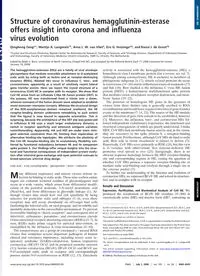
2008 Structure of coronavirus hemagglutinin-esterase offers insight into corona and influenza virus evolution PDF
Preview 2008 Structure of coronavirus hemagglutinin-esterase offers insight into corona and influenza virus evolution
Structure of coronavirus hemagglutinin-esterase offers insight into corona and influenza virus evolution Qinghong Zeng*†, Martijn A. Langereis†‡, Arno L. W. van Vliet‡, Eric G. Huizinga*§, and Raoul J. de Groot‡§ *Crystal and Structural Chemistry, Bijvoet Center for Biomolecular Research, Faculty of Sciences, and ‡Virology Division, Department of Infectious Diseases and Immunology, Faculty of Veterinary Medicine, Utrecht University, 3584 CL, Utrecht, The Netherlands Edited by Ralph S. Baric, University of North Carolina, Chapel Hill, NC, and accepted by the Editorial Board April 11, 2008 (received for review January 18, 2008) The hemagglutinin-esterases (HEs) are a family of viral envelope glycoproteins that mediate reversible attachment to O-acetylated sialic acids by acting both as lectins and as receptor-destroying enzymes (RDEs). Related HEs occur in influenza C, toro-, and coronaviruses, apparently as a result of relatively recent lateral gene transfer events. Here, we report the crystal structure of a coronavirus (CoV) HE in complex with its receptor. We show that CoV HE arose from an influenza C-like HE fusion protein (HEF). In the process, HE was transformed from a trimer into a dimer, whereas remnants of the fusion domain were adapted to establish novel monomer–monomer contacts. Whereas the structural design of the RDE-acetylesterase domain remained unaltered, the HE receptor-binding domain underwent remodeling to such extent that the ligand is now bound in opposite orientation. This is surprising, because the architecture of the HEF site was preserved in influenza A HA over a much larger evolutionary distance, a switch in receptor specificity and extensive antigenic variation notwithstanding. Apparently, HA and HEF are under more strin- gent selective constraints than HE, limiting their exploration of alternative binding-site topologies. We attribute the plasticity of the CoV HE receptor-binding site to evolutionary flexibility con- ferred by functional redundancy between HE and its companion spike protein S. Our findings offer unique insights into the struc- tural and functional consequences of independent protein evolu- tion after interviral gene exchange and open potential avenues to broad-spectrum antiviral drug design. sialic acid � x-ray crystallography � glycoprotein � lectin � nidovirus M any different respiratory and enteric viruses initiate in- fection by binding to sialic acids. These nine-carbon amino sugars are common terminal residues of glycoconjugates and occur in a wide variety, which arises from differential modifi- cation of the parental molecule, 5-N-acetyl neuraminic acid (Neu5Ac), and from differences in glycosidic linkage (1). Al- though viruses may attain host and cell specificity by being selective for particular sialic acid subtypes (1–4), even these receptors may still occur abundantly on off-target host cells (including the infected cell), on viral progeny, and on soluble and insoluble molecules in the extracellular environment. To prevent irreversible binding to ‘‘decoy receptors’’ and consequent loss of infectivity, orthomyxo-, paramyxo-, and coronaviruses encode virion-associated receptor-destroying enzymes (RDEs) (5–7). In turn, RDEs make prime targets for antiviral intervention, as exemplified by the influenza A virus neuraminidase (8–10). The coronaviruses are a group of enveloped (�)strand RNA viruses that comprises several important pathogens of human clinical and veterinary importance, including severe acute re- spiratory syndrome (SARS)-coronavirus, human respiratory coronavirus (HCoV) OC43 and its proposed zoonotic ancestor (11), bovine coronavirus (BCoV). HCoV-OC43 and BCoV use 9-O-acetylated sialic acids as receptor and correspondingly possess sialate-9-O-acetylesterases as RDE (12, 13). Enzymatic activity is associated with the hemagglutinin-esterase (HE), a homodimeric class I membrane protein (for a review, see ref. 7). Although among coronaviruses, HE is exclusive to members of phylogenetic subgroup 2a (7), closely related proteins do occur in toroviruses (14–16) and in orthomyxoviruses of mammals (17) and fish (18). Best studied is the influenza C virus HE fusion protein (HEF), a homotrimeric multifunctional spike protein that mediates virion attachment, receptor destruction, and mem- brane fusion (19–22). The presence of homologous HE genes in the genomes of viruses from three distinct taxa is generally ascribed to RNA recombination and would have required two lateral gene transfer events at the minimum (7, 14, 23). The source of the HE module and the direction of gene flow remain to be established, however (7). Moreover, the influenza, toro-, and coronavirus HEs fol- lowed independent evolutionary trajectories, the functional and structural consequences of which are poorly understood. Unlike HEF, CoV HEs lack membrane fusion activity and, in the virion, they are accessory to the spike protein S, a receptor-binding fusion protein. Furthermore, although CoV HEs do bind to sialic acid, their role in virion attachment is subject to debate (7). Reportedly, CoV HEs serve primarily as RDE (24), but this view is at variance with observations that esterase-deficient HE promotes viral spread in vivo (25). Intriguingly, there is no obvious sequence homology between the HEF receptor-binding site and corresponding regions in HE, raising the question of whether CoV HEs possess a separate receptor-binding site or mediate sialic acid-binding and catalysis through a single site in the esterase pocket (7). To further our understanding of the function and evolution of coronavirus HEs, we expressed BCoV HE and solved its structure, free and in complex with its receptor. Results and Discussion Expression, Purification, and Biochemical Analysis of CoV HE. We produced the ectodomain of BCoV HE (residues 19–388) in enzymatically active (HE) and inactive form (HE0, containing an Author contributions: Q.Z., M.A.L., E.G.H., and R.J.d.G. designed research; Q.Z., M.A.L., and A.L.W.v.V. performed research; Q.Z., M.A.L., E.G.H., and R.J.d.G. analyzed data; and Q.Z., M.A.L., E.G.H., and R.J.d.G. wrote the paper. The authors declare no conflict of interest. This article is a PNAS Direct Submission. R.S.B. is a guest editor invited by the Editorial Board. Data deposition: The data reported in this paper have been deposited in the Protein Data Bank, www.pdb.org [PDB ID codes 3CL4 (wild-type BCoV HE) and 3CL5 (BCoV HE0 com- plexed with Neu4,5,9Ac32Me)]. See Commentary on page 8807. †Q.Z. and M.A.L. contributed equally to this work. §To whom correspondence may be addressed. E-mail:
